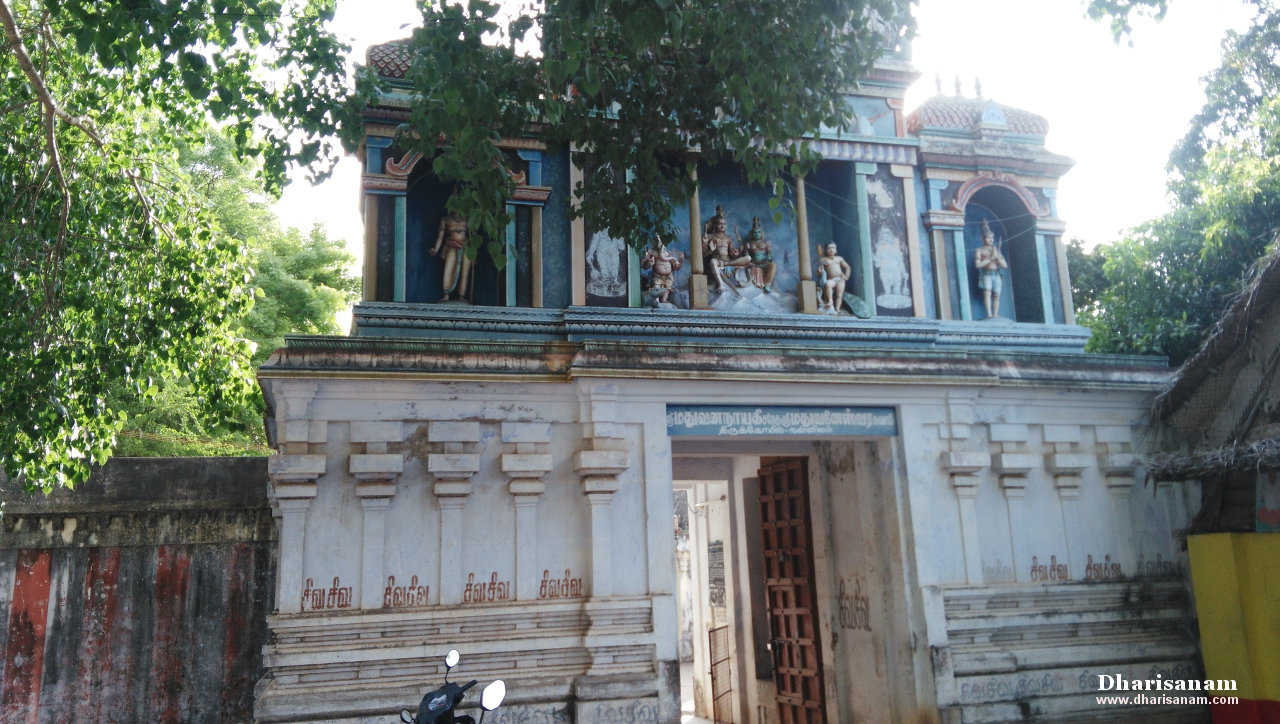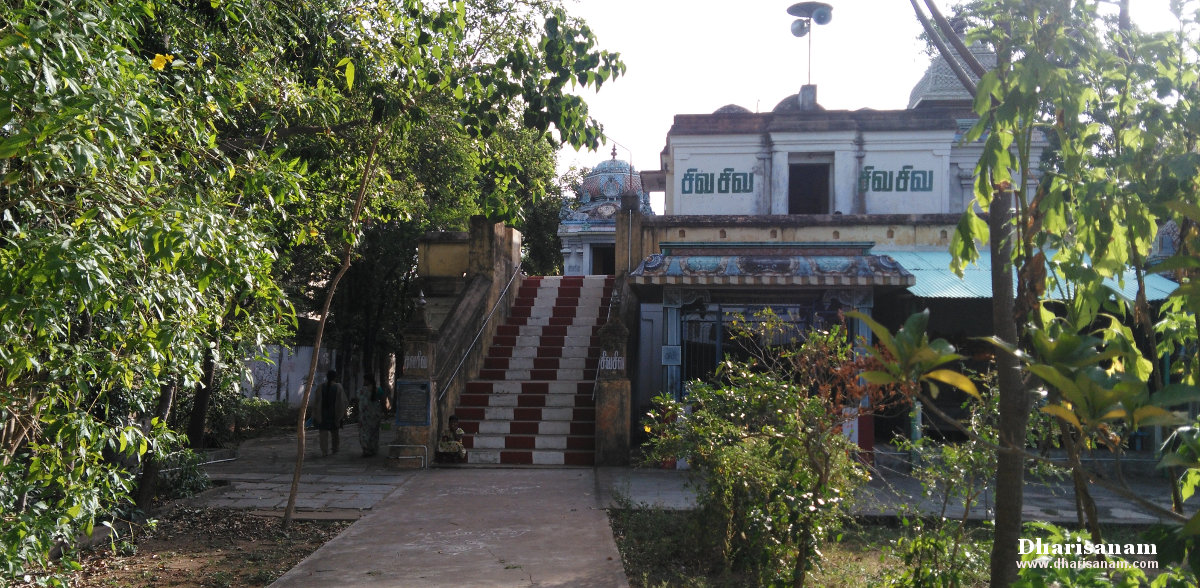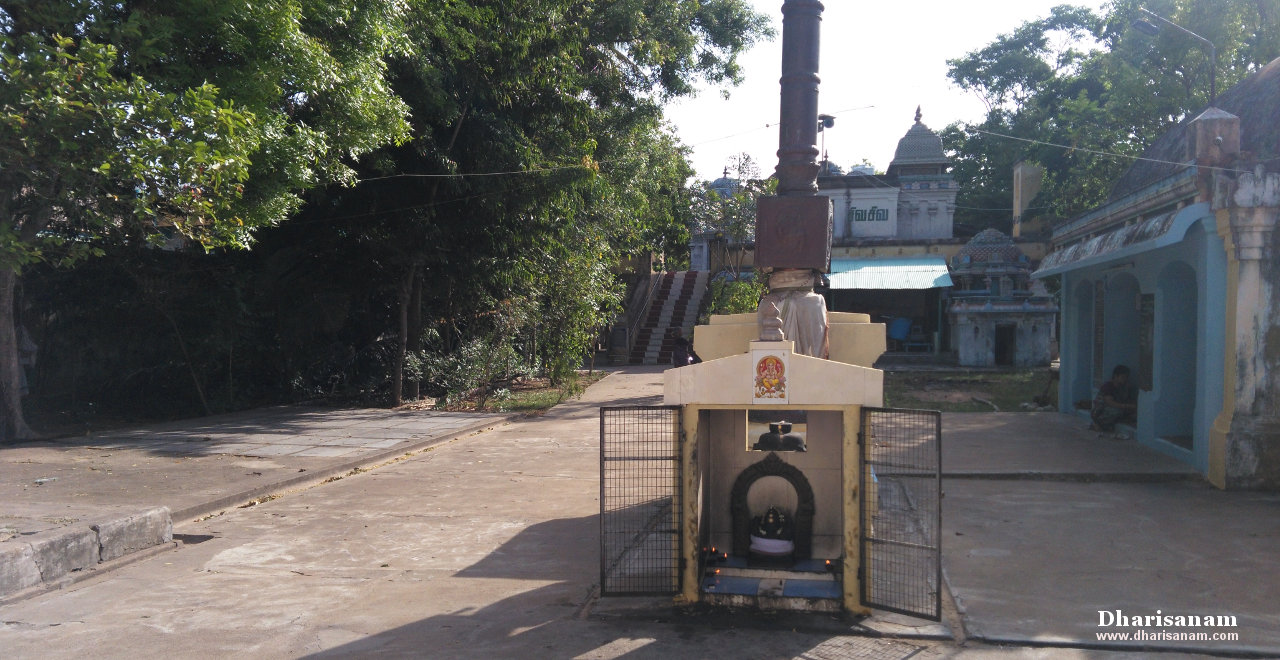Visited on: 11th June, 2018.
Location
Nannilam is situated at a distance of about 30 kms from Kumbakonam on the Kumbakonam to Nagore route. It can also be reached from Mayiladuthurai (30 kms) and Thiruvarur (17 kms) on the Mayiladuthurai to Thiruvarur route. Nearest railway station is Nannilam which is 5 kms away from this temple.
Other Devara Paadal Petra Shiva Sthalams near this place are –
Thiru Kondeecharam, Srivanchiyam, Thiru Panaiyur, Thiru Pukalur, Thiru Pukalur Vardhamaneecharam, Ramanadeecharam, Thirumarugal, Thiru Payatrur and Thiru Chenkattangudi.
General Information
| Moolavar | Sri Madhuvaneswarar, Sri Brahatheeswarar, Sri Devaranyeswarar, Sri Prakasa Nathar |
| Ambal | Sri Madhu Vana Nayaki, Sri Periya Nayaki, Sri Deva Kaanthara Nayaki |
| Theertham (Holy water) | Brahma Theertham, Sula Theertham, Deva Theertham |
| Sthala Vriksham (Sacred Tree) | Vilvam |
| Pathigam (Hymn) rendered by | Saint Sundaramurthy (Sundarar)-1 |
- This is one of the 276 Devara Paadal Petra Shiva Sthalams and 71st Shiva Sthalam on the Southern bank of the river Cauveri in Chozha Nadu (Thenkarai).
- Lord Shiva in this temple is a Swayambumurthi (self-manifested).
- This temple is counted as one of the Maadak Koils built by Chola King Kochenganan.
- This east facing temple’s main tower is not tiered. In place of the Gopuram, there is a beautiful sculpture depicting Lord Shiva and Goddess Parvathy.
- The last consecration ceremony (Maha Kumbabishekam) took place on 14.09.2008 and prior to that on 15.09.1996.
History of the Temple
The historical names of this place are Sundaravani, Madhuvanam, Devaranyam, Sundaravanam and Bruhathpuram.
This place is surrounded by fertile agricultural land; hence it gets the name Nannilam (“Nalla” means good and “nilam” means land in Tamil).
This ancient temple is located on the southern bank of the river Mudikondan. This place is referred as Nannilam and the temple is known as “Perungkoil” (big temple).
As per stone inscriptions in this temple, the temple was built in the 9th century by Chola King Kochenganan.
This temple is under the administrative control of the Hindu Religious and Charitable Endowments Department of Government of Tamil Nadu (HR&CE).



Legend
It is believed that Lord Suryan worshiped the lord in this temple.
According to legend, once the Devas were tortured by the demon, Viruthirasuran, in the celestial world. Devas took asylum here and worshiped Lord Shiva. It is believed that Lord Shiva turned the Devas into bees in order to save them from the demon. The lord made a beehive in the form of a lingam in the Sanctum Sanctorum and asked the Devas to stay in it. Hence in this place, the lord and the goddess are called as “Madhuvanam”, “Sri Madhuvaneswarar” and “Sri Madhuvana Nayaki” respectively (“madhu” means honey in Tamil). To substantiate this legend, there are still few beehives in this temple, but it is stated that the bees do not harm anyone.
Another legend is that Somapuri King Bruhathrajan had performed penanced here in Krutha Yuga. Pleased with his penance, Lord Shiva blessed him with his darshan in the form of “Tejo Lingam”. The king requested the lord to make a pond using his trident and fill it with water from the holy Ganges. This theertham is known as Bruhath Gangai and Sula Theertham.
Another legend is that the Devas came to this place in the form of women, took asylum and worshiped Lord Shiva. They took asylum in order to protect themselves from the demon Salantharasuran. They offered the water from the Sula theertham to Lord Shiva and prayed for his help. Pleased with their prayers, Lord Shiva vanquished the demon in Virkudi, a nearby place, which is also a Devara Paadal Petra Sthalam, and saved the Devas. Hence this place also gets the name Devaranyam and the theertham is also known as Deva theertham.
It is believed that Lord Indra visited this place and took a dip in the Sula Theertham and worshiped the lord. He was relieved from his “Brahmahathi dosha” which he had accrued due to the killing of demon Viruthirasuran.
It is believed that lords Brahma, Indra, Suryan, Sage Agasthiyar, Devas (in the form of bees) and Saint Sundarar have worshiped the lord here.
As per Sthala Puranam, four Shivalingams were installed and worshiped at the four corners of this place. These lingams were installed by - lord Yama in South, lord Varuna in West, lord Indra in East and lord Kubera in North.
Deities in the temple
Other than the shrines of Lord Shiva and Goddess Parvathy, shrines and idols of Sidhi vinayakar, Vinayakar, Nagar, Murugan with his consorts, Mahalakshmi, Bairavar, Suryan, Saneeswarar, Chithra Guptha, Navagraham and Chandikeswarar can be seen in the corridors.
In the “koshtam” (place surrounding the sanctum sanctorum), idols of Narthana Vinayakar, Dakshinamurthy, Lingothbavar, Brahma and Durgai can be seen.
Shivalingams worshiped by Lord Brahma (Sri Mahadeva lingam) and Sage Agasthiyar (Sri Agastheeswarar lingam) are in the corridor.
The Shivalingams worshiped by lords Yama, Varuna, Indran and Guberan are also present in the corridors.







Salient Features
In his hymn, Saint Sundaramurthy Nayanar mentioned that this temple was built by Kochengat Cholan. He also referred to this temple as “Nannilaththu Perum Kovil”.
There are many specialities in this temple such as - Bairavar is located by the side of Suryan; all the idols in the Navagraham are facing the Suryan; Suryan and Guru are facing each other; and Chithra Guptha and Saneeswarar can be seen in separate shrines.
It is considered very auspicious to take a dip in the Brahma Theertham during “Masi Maham” in the Tamil month of Masi (Feb-Mar).
It is believed that Chola King Kochenganan built about 70 “Madakkoils”. The distinguishing feature of a Madakkoil is that it is not easily approachable by an elephant. He built these temples at an elevation and there are a few steps that need to be climbed before seeing the lord. Also, the sanctum sanctorum’s (Karpagragam) entrance is narrow such that no elephant can enter it. In this temple, there are about 18 steps to reach Lord Shiva’s shrine.
It is believed that this temple’s Sthala Viruksham are Vilvam, Kongu, Vengai, Madhavi and Sanbagam. However, now only Vilvam tree can be seen in this temple.
Greatness of this temple
It is believed that worshiping the lord here will cure one from all kinds of nervous ailments.
It is also believed that one can get salvation by worshiping the lord here during “Ekadasi” (11th day of full moon or new moon days) and “Pradosham” (13th day of full moon or new moon days).
Important Festivals
Some of the important festivals celebrated in this temple are –
Vaikasi Visakam in the Tamil month of Vaikasi (May-June),
Aani Thirumanjanam in the Tamil month of Aani (June-July),
Aadi Pooram in the Tamil month of Aadi (July-Aug),
Vinayakar Chaturthi in the Tamil month of Aavani (Aug-Sept),
Navarathri in the Tamil month of Purattasi (Sept-Oct),
Skanda Shashti and Annabishekam in the Tamil month of Aippasi (Oct–Nov),
Thiru Karthikai in the Tamil month of Karthikai (Nov-Dec),
Thiruvadhirai in the Tamil month of Markazhi (Dec-Jan),
Makara Sankranthi and Thai Poosam in the Tamil month of Thai (Jan-Feb) and
Shivrathri in the Tamil month of Masi (Feb-Mar).
Pradosham is also observed regularly.
Saint Sundarar’s Guru Puja on the Aadi Swathi star day in the Tamil month of Aadi (July-Aug) is also celebrated.
Temple Timings
From 07:00 AM to 12:00 Noon and from 04:00 PM to 08:30 PM.
Temple Address
Sri Madhuvaneswarar Temple,
Nannilam Post & Taluk,
Thiruvarur District,
Tamil Nadu – 610 105.
Tele: +91 - 94426 82346, 99432 09771.
This temple’s priest Sri Sivakumar Gurukkal can be contacted at +91 – 79043 74770.






Pathigam (Hymn) with English transliteration and Tamil meaning.
Saint Sundaramurthy Nayanar visited this temple and sang this Pathigam.
Devotees visiting this temple should make it a practice to recite this Pathigam.
Pathigam No.7.098.
தண்ணியல் வெம்மையி னான்றலை யிற்கடை தோறும்பலி
பண்ணியல் மென்மொழி யார்இடக் கொண்டுழல் பண்டரங்கன்
புண்ணிய நான்மறை யோர்முறை யாலடி போற்றிசைப்ப
நண்ணிய நன்னிலத் துப்பெருங் கோயில் நயந்தவனே.
“Thaṇṇiyal vem'maiyi ṉāṉtṟalai yiṟkaṭai thōṟumpali
paṇṇiyal meṉmozhi yār'iṭak koṇṭuzhal paṇṭaraṅkaṉ
puṇṇiya nāṉmaṟai yōrmuṟai yālaṭi pōtṟisaippa
naṇṇiya naṉṉilath thupperuṅ kōyil nayanthavaṉē”.
புண்ணியத்தைச் செய்கின்ற, நான்கு வேதங்களையும் உணர்ந்த அந்தணர்கள், முறைப்படி தனது, திருவடிக்குப் போற்றி சொல்லி வழிபடும்படி, பலரும் அடைந்து வணங்கும் திருநன்னிலத்தில் உள்ள பெருங்கோயிலை விரும்பி எழுந்தருளியிருக்கின்ற பெருமான், தண்ணிய இயல்பினையும், வெவ்விய இயல்பினையும் ஒருங்குடையவன்; வாயில்கள்தோறும் சென்று, பண்போலும் இயல்பினையுடைய இனிய மொழியையுடைய மகளிரிடம் தலையோட்டில் பிச்சை யேற்றுத்திரிகின்ற 'பாண்டரங்கம்' என்னும் கூத்தினை யுடையவன்.
வலங்கிளர் மாதவஞ் செய்மலை மங்கையோர் பங்கினனாய்ச்
சலங்கிளர் கங்கைதங் கச்சடை யொன்றிடை யேதரித்தான்
பலங்கிளர் பைம்பொழில் தண்பனி வெண்மதி யைத்தடவ
நலங்கிளர் நன்னிலத் துப்பெருங் கோயில் நயந்தவனே.
“Valaṅkiḷar māthavañ cheymalai maṅkaiyōr paṅkiṉaṉāych
chalaṅkiḷar gaṅgaithaṅ kachchaṭai yoṉtṟiṭai yēthariththāṉ
palaṅkiḷar paimpozhil thaṇpaṉi veṇmathi yaiththaṭava
nalaṅkiḷar naṉṉilath thupperuṅ kōyil nayanthavaṉē”.
பயன் மிகுந்த, பசிய சோலைகள், குளிர்ந்த, வெள்ளிய சந்திரனைத் தடவுதலால் அழகு மிகுகின்ற திருநன்னிலத்தில் உள்ள பெருங்கோயிலை விரும்பி எழுந்தருளியிருக்கின்ற பெருமான், வெற்றி மிக்க, பெரிய தவத்தைச் செய்த மலைமகளை ஒருபாகத்தில் உடையவனாய், வெள்ளம் மிகுந்த கங்கையைத் தனது சடைகளுள் ஒன்றிலே தங்கும்படி தடுத்து வைத்துள்ளான்.
கச்சிய னின்கருப் பூர்விருப் பன்கரு திக்கசிவார்
உச்சியன் பிச்சையுண் ணியுல கங்களெல் லாமுடையான்
நொச்சியம் பச்சிலை யான்நுரை தீர்புன லாற்றொழுவார்
நச்சிய நன்னிலத் துப்பெருங் கோயில் நயந்தவனே.
“Kachchiya ṉiṉkarup pūrvirup paṉkaru thikkasivār
uchchiyaṉ pichchaiyuṇ ṇiyula kaṅkaḷel lāmuṭaiyāṉ
nochchiyam pachchilai yāṉnurai thīrpuṉa lātṟozhuvār
nachchiya naṉṉilath thupperuṅ kōyil nayanthavaṉē”.
நொச்சியின் பச்சிலையும், நுரை இல்லாத தூய நீரும் கொண்டு வழிபடுவோர் விரும்புகின்ற திருநன்னிலத்தில் உள்ள பெருங்கோயிலை விரும்பி எழுந்தருளியிருக்கின்ற பெருமான். கச்சிப்பதியில் எழுந்தருளியிருப்பவன்; இனிய கரும்பின்கண் செல்லுகின்ற விருப்பம்போலும் விருப்பம் செல்லுதற்கு இடமானவன்; தன்னை நினைந்து உருகுபவரது தலைமேல் இருப்பவன்; பிச்சையேற்று உண்பவன்; உலகங்கள் எல்லாவற்றையும் உடையவன்.
பாடிய நான்மறை யான்படு பல்பிணக் காடரங்கா
ஆடிய மாநடத் தானடிபோற்றியென் றன்பினராய்ச்
சூடிய செங்கையி னார்பல தோத்திரம் வாய்த்தசொல்லி
நாடிய நன்னிலத் துப்பெருங் கோயில் நயந்தவனே.
“Pāṭiya nāṉmaṟai yāṉpaṭu palpiṇak kāṭaraṅkā
āṭiya mānaṭath thāṉaṭipōtṟiyeṉ tṟaṉpiṉarāych
chūṭiya seṅkaiyi ṉārpala thōththiram vāyththasolli
nāṭiya naṉṉilath thupperuṅ kōyil nayanthavaṉē”.
தலைமேற் குவித்த கையை உடைய பலர், மிக்க அன்புடையவர்களாய். 'திருவடி போற்றி' என்று, பொருந்திய தோதிரங்களைச் சொல்லி அடைகின்ற திருநன்னிலத்தில் உள்ள பெருங்கோயிலை விரும்பி எழுந்தருளியிருக்கின்ற இறைவன், தன்னால் பாடப்பட்ட நான்கு வேதங்களை யுடையவன்; இறந்த பல பிணங்களையுடைய காடே அரங்கமாக ஆடுகின்ற, சிறந்த நடனத்தையுடையவன்.
பிலந்தரு வாயினொ டுபெரி தும்வலி மிக்குடைய
சலந்தரன் ஆகம் இருபிள வாக்கிய சக்கரமுன்
நிலந்தரு மாமகள் கோன்நெடு மாற்கருள் செய்தபிரான்
நலந்தரு நன்னிலத் துப்பெருங் கோயில் நயந்தவனே.
“Pilantharu vāyiṉo ṭuperi thumvali mikkuṭaiya
salantharaṉ ākam irupiḷa vākkiya sakkaramuṉ
nilantharu māmakaḷ kōṉneṭu māṟkaruḷ seythapirāṉ
nalantharu naṉṉilath thupperuṅ kōyil nayanthavaṉē”.
நன்மையைத் தருகின்ற திருநன்னிலத்தில் உள்ள பெருங்கோயிலை விரும்பி எழுந்தருளியிருக்கின்ற பெருமான், பிலம் போன்ற வாயையும், பெரிதும் மிகுந்த வலிமையையும் உடைய சலந்தராசுரனது உடலை இரண்டு பிளவாகச் செய்த சக்கராயுதத்தை, முன்பு, மண்ணை உண்டு உமிழ்ந்த திருமகள் கணவனாகிய திருமாலுக்கு அளித்த தலைவன்.
வெண்பொடி மேனியி னான்கரு நீல மணிமிடற்றான்
பெண்படி செஞ்சடை யான்பிர மன்சிரம் பீடழித்தான்
பண்புடை நான்மறை யோர்பயின் றேத்திப்பல் கால்வணங்கும்
நண்புடை நன்னிலத் துப்பெருங் கோயில் நயந்தவனே.
“Veṇpoṭi mēṉiyi ṉāṉkaru nīla maṇimiṭatṟāṉ
peṇpaṭi cheñchaṭai yāṉbira maṉsiram pīṭazhiththāṉ
paṇpuṭai nāṉmaṟai yōrpayiṉ tṟēththippal kālvaṇaṅkum
naṇpuṭai naṉṉilath thupperuṅ kōyil nayanthavaṉē”.
நல்ல பண்பினையுடைய நான்கு வேதங்களை உணர்ந்தவர்களாகிய அந்தணர்கள், பல மந்திரங்களையும் நன்கு பயின்று, பன்முறை துதித்து வணங்கும், நட்பாம் தன்மையுடைய திருநன்னிலத்தில் உள்ள பெருங்கோயிலை விரும்பி எழுந்தருளியிருக்கின்ற பெருமான், வெண்பொடியைப் பூசிய மேனியை உடையவன்; நீல மணிபோலும் கரிய கண்டத்தை யுடையவன்; கங்கையாகிய பெண் பொருந்தியுள்ள சடையை உடையவன்; பிரமதேவனது தலையை, பெருமை கெட அறுத்தவன்.
தொடைமலி கொன்றைதுன் றுஞ்சடை யன்சுடர் வெண்மழுவாட்
படைமலி கையன்மெய் யிற்பகட் டீருரிப் போர்வையினான்
மடைமலி வண்கம லம்மலர் மேல்மட வன்னம்மன்னி
நடைமலி நன்னிலத் துப்பெருங் கோயில் நயந்தவனே.
“Thoṭaimali koṉtṟaithuṉ tṟuñchaṭai yaṉchuṭar veṇmazhuvāṭ
paṭaimali kaiyaṉmey yiṟpakaṭ ṭīrurip pōrvaiyiṉāṉ
maṭaimali vaṇkama lam'malar mēlmaṭa vaṉṉam'maṉṉi
naṭaimali naṉṉilath thupperuṅ kōyil nayanthavaṉē”.
இளமையான அன்னப் பறவைகள், நீர்மடைகளில் நிறைந்துள்ள, வளவிய தாமரை மலர்மேல் தங்கிப் பின் அப்பாற் சென்று நடத்தல் நிறைந்த திருநன்னிலத்தில் உள்ள பெருங்கோயிலை விரும்பி எழுந்தருளியிருக்கின்ற பெருமான், மாலையாக நிறைந்த கொன்றைமலர் பொருந்திய சடையை உடையவன்; ஒளிவீசுகின்ற வெள்ளிய மழுவாகிய ஆளும் படைக்கலம் நிறைந்த கையை உடையவன்; திருமேனியில் யானையினது உரித்த தோலாகிய போர்வையை உடையவன்.
குளிர்தரு திங்கள்கங் கைகுர வோடரக் கூவிளமும்
மிளிர்தரு புன்சடை மேலுடை யான்விடை யான்விரைசேர்
தளிர்தரு கோங்குவேங் கைதட மாதவி சண்பகமும்
நளிர்தரு நன்னிலத் துப்பெருங் கோயில் நயந்தவனே.
“Kuḷirtharu thiṅkaḷgaṅ gaikura vōṭarak kūviḷamum
miḷirtharu puṉsaṭai mēluṭai yāṉviṭai yāṉviraisēr
thaḷirtharu kōṅkuvēṅ kaithaṭa māthavi saṇpakamum
naḷirtharu naṉṉilath thupperuṅ kōyil nayanthavaṉē”.
நறுமணம் பொருந்திய, தளிர்களைத் தருகின்ற கோங்கு, வேங்கை, வளைவையுடைய குருக்கத்தி, சண்பகம் முதலிய பூமர வகைகள் பலவும் குளிர்ச்சியைத் தருகின்ற திருநன்னிலத்தில் உள்ள பெருங்கோயிலை விரும்பி எழுந்தருளியிருக்கின்ற பெருமான், தனது ஒளிவீசுகின்ற, புல்லிய சடையின்மேல், குளிர்ச்சியைத் தருகின்ற சந்திரன், கங்கை, பாம்பு, குராமலர், கூவிள இலை முதலிய இவைகளை உடையவன்; இடபத்தை ஊர்கின்றவன்.
கமர்பயில் வெஞ்சுரத் துக்கடுங் கேழற்பின் கானவனாய்
அமர்பயில் வெய்திய ருச்சுன னுக்கருள் செய்தபிரான்
தமர்பயில் தண்விழ வில்தகு சைவர் தவத்தின்மிக்க
நமர்பயில் நன்னிலத் துப்பெருங் கோயில் நயந்தவனே.
“Kamarpayil veñchurath thukkaṭuṅ kēzhaṟpiṉ kāṉavaṉāy
amarpayil veythiya ruchchuṉa ṉukkaruḷ seythapirāṉ
thamarpayil thaṇvizha vilthaku saivar thavaththiṉmikka
namarpayil naṉṉilath thupperuṅ kōyil nayanthavaṉē”.
உலகத்தவர் மிக்குள்ள தண்ணிய விழாக்களையுடைய, தகுதிவாய்ந்த சைவர்களாகிய, தவத்திற் சிறந்த நம்மவர் மிக்கு வாழ்கின்ற திருநன்னிலத்தில் உள்ள பெருங்கோயிலை விரும்பி எழுந்தருளியிருக்கின்ற பெருமான், நிலப் பிளப்புக்கள் மிகுந்த கொடிய கற்சுரத்தில், கொடிய பன்றியின்பின்னே வேடுவனாய்ச் சென்று அருச்சுனனோடு போராடுதலைப் பொருந்தி, அவனுக்குத் திருவருள் செய்த தலைவனாவான்.
கருவரை போலரக் கன்கயி லைம்மலைக் கீழ்க்கதற
ஒருவிர லாலடர்த் தின்னருள் செய்த உமாபதிதான்
திரைபொரு பொன்னிநன் னீர்த்துறை வன்றிகழ் செம்பியர்கோன்
நரபதி நன்னிலத் துப்பெருங் கோயில் நயந்தவனே.
“Karuvarai pōlarak kaṉkayi laim'malaik kīzhkkathaṟa
oruvira lālaṭarth thiṉṉaruḷ seytha umāpathithāṉ
thiraiporu poṉṉinaṉ ṉīrththuṟai vaṉtṟikazh sempiyarkōṉ
narapathi naṉṉilath thupperuṅ kōyil nayanthavaṉē”.
அலை மோதுகின்ற காவிரியாற்றினது நல்ல நீர்த்துறையை உடையவனும், சோழர்கோமகனும் ஆகிய அரசன் செய்த, திருநன்னிலத்துப் பெருங்கோயிலை விரும்பி எழுந்தருளியிருக்கின்ற பெருமான், அரக்கனாகிய இராவணன், கயிலாய மலையின்கீழ், கரியமலைபோலக் கிடந்து கதறும்படி ஒரு விரலால் நெருக்கிப் பின்பு அவனுக்கு அருள்புரிந்த உமை கணவனாகும்.
கோடுயர் வெங்களிற் றுத்திகழ் கோச்செங்க ணான்செய்கோயில்
நாடிய நன்னிலத் துப்பெருங் கோயில் நயந்தவனைச்
சேடியல் சிங்கிதந் தைசடை யன்றிரு வாரூரன்
பாடிய பத்தும்வல் லார்புகு வார்பர லோகத்துள்ளே.
“Kōṭuyar veṅkaḷit ṟuththikazh kōchcheṅka ṇāṉseykōyil
nāṭiya naṉṉilath thupperuṅ kōyil nayanthavaṉaich
chēṭiyal siṅkithan thaisaṭai yaṉtṟiru vārūraṉ
pāṭiya paththumval lārpuku vārpara lōkaththuḷḷē”.
தந்தங்கள் உயர்ந்து காணப்படுகின்ற வெவ்விய யானையின்மேல் விளங்குகின்ற கோச்செங்கட்சோழ நாயனார் செய்த, யாவரும் விரும்புகின்ற, திருநன்னிலத்தில் உள்ள பெருங்கோயிலை விரும்பி எழுந்தருளியிருக்கின்ற பெருமானை, அழகு பொருந்திய சிங்கடிக்குத் தந்தையும், சடையனார்க்கு மகனும் ஆகிய நம்பியாரூரன் பாடிய இப்பத்துப் பாடல்களையும் பாட வல்லவர்கள், பரலோகத்துள் புகுவார்கள்.







